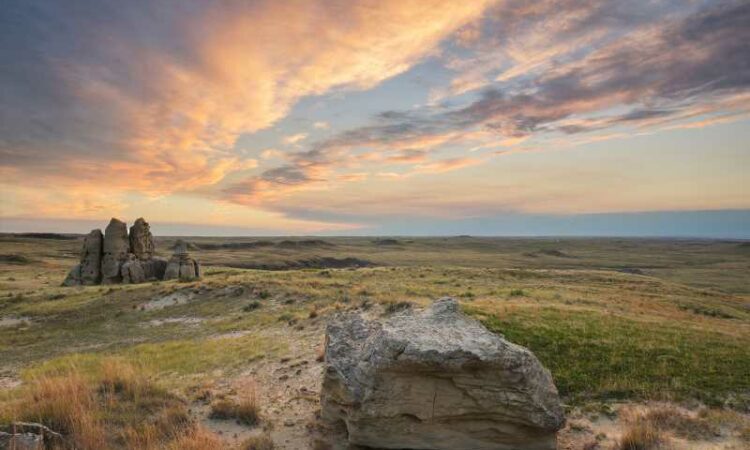© Photo by Shutterstock
Montana’s Medicine Rocks State Park Is Now a Dark Sky Sanctuary
Photo by Shutterstock There is little to no light pollution to block views of the night skies on the prairies of Medicine Rock State Park in Montana.
If you’ve bookmarked our handy 2021 meteor shower calendar, you know when to seek out dark skies this year. But if you’re looking for where to watch the Perseids this August or the Geminids in December, the United States has two new dark sky places to add to your list of stargazing destinations to visit.
In December 2020, the International Dark-Sky Association (IDA) designated Medicine Rocks State Park in Montana a certified International Dark Sky Sanctuary and Voyageurs National Park in Minnesota an International Dark Sky Park.
Founded in 2001, the IDA is a conservation program that has classified more than 130 certified International Dark Sky Places around the world; they are designated based on the type of land and the outreach programs each destination provides to the public.
Video: Reawakened Yellowstone geyser won’t predict the volcanic ‘big one,’ scientists say (FOX News)
Missing winter cruises? Here are 4 warm-weather trip ideas for the holiday season
USA TODAY
Missing winter cruises? Here are 4 warm-weather trip ideas for the holiday season
Holiday cruises may be suspended this year thanks to COVID-19 but here are 4 other warm-weather trip ideas with socially-distanced experiences.
USA TODAY
Dark Sky Parks—like Voyageurs—are considered to be “publicly- or privately-owned spaces protected for natural conservation that implement good outdoor lighting and provide dark sky programs for visitors.” (Many other U.S. national parks like the Grand Canyon and Petrified Forest in Arizona and Death Valley and Joshua Tree in California are also International Dark Sky Parks.)
Dark Sky Sanctuaries are distinguished from Dark Sky Parks by their particularly remote locations. With the addition of Medicine Rocks State Park, there are now 14 Dark Sky Sanctuaries worldwide; these are often the darkest places on the globe whose conservation state is most fragile, according to the IDA.
© Photo by Shutterstock
Voyageurs National Park is located far enough north to see the aurora borealis.
Photo by Shutterstock Voyageurs National Park is located far enough north to see the aurora borealis.
Located in southeastern Montana near the borders of North and South Dakota, Medicine Rocks State Park is roughly 250 miles east of Billings, Montana, 176 miles north of Rapid City, South Dakota, and 236 miles west of Bismark, North Dakota. In addition to its dark skies, Medicine Rocks is also known for its Swiss cheese–like sandstone rock formations and wildlife viewing (expect mule deer, antelope, and sharp-tailed grouse sightings during the day).
To celebrate its new designation, Medicine Rocks State Park will host a series of star-viewing parties on May 22, June 20, July 22, and August 18, 2021, together with the Carter County Museum, Montana State Parks, and the Montana Chapter of the IDA. Visit cartercountymuseum.org for more information.
Located near the Canadian border and roughly 114 miles north of Grand Rapids, Minnesota, Voyageurs became a national park in 1975 and gets its name from the French Canadian fur traders who traveled along its interconnected waterways hundreds of years ago.
In order to earn its Dark Sky Park designation, the staff of Voyageurs National Park had to retrofit existing exterior lights at park facilities to minimize light pollution. While Voyageurs hasn’t planned any official celebration yet, keep in mind that when the northern lights are active they are often visible from this location in the United States.
To see the full list of Dark Sky Places, visit the association’s interactive map. And even though these locations have little to no man-made light pollution, you’ll also want to check a moon calendar to avoid any natural light pollution during your next stargazing trip.
>> Next: 9 Best Stargazing Destinations in the World
Source: Read Full Article



